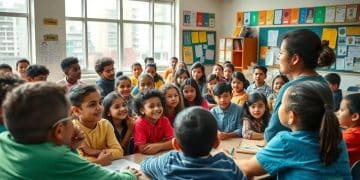How remote learning is transforming traditional education

Remote learning is transforming traditional education by integrating technology, promoting flexibility, and enabling personalized learning experiences, while also presenting challenges like engagement and equitable access to resources.
How remote learning is transforming traditional education is not just a trend but a powerful shift. Have you ever thought about how this affects students and teachers alike? Let’s dive into this intriguing transformation.
Understanding remote learning and its rise
Understanding remote learning is essential in today’s education landscape. It has become a vital method for students and teachers alike. But what exactly is remote learning? Simply put, it is a way to receive education outside of the traditional classroom, often utilizing technology to facilitate learning.
This approach saw a significant rise during the global pandemic, pushing schools to adapt quickly.
Key Features of Remote Learning
Remote learning enables students to learn from anywhere, making education accessible. It often includes a mix of live lectures, recorded classes, and assignments. Here are some key features that define remote learning:
- Flexibility: Students can learn at their own pace.
- Variety of Resources: Access to online materials, videos, and interactive content.
- Global Connectivity: Opportunities to connect with peers and educators worldwide.
- Cost-Effective: Reducing commuting and physical resource expenses.
These features contribute to the growing popularity of remote learning. Schools have started to incorporate various digital platforms, enhancing the learning experience.
Moreover, remote learning promotes self-discipline and accountability among students. They learn to manage their time effectively, ultimately preparing them for future challenges.
As we delve deeper, it’s important to highlight how various technologies aid this transformation. For instance, tools like video conferencing software, learning management systems, and educational apps play pivotal roles.
Challenges of Adopting Remote Learning
While remote learning offers many advantages, it comes with its own set of challenges. One major concern is the digital divide; not every student has equal access to necessary technology and internet connectivity. This gap can lead to inequalities in learning opportunities.
Additionally, maintaining student engagement can be more challenging in a virtual setting. Without the physical presence of teachers and peers, some students may struggle to stay motivated.
To address these issues, educators are continually seeking innovative strategies to engage students and provide support, ensuring that learning remains effective and inclusive.
In summary, understanding remote learning is crucial for adapting to the future of education. Its rise reflects the flexibility and accessibility of modern learning environments, presenting both opportunities and challenges.
Benefits of remote learning for students

Remote learning offers multiple benefits for students, significantly altering their educational experience. This mode of learning allows for a more personalized approach, where students can study in an environment that suits them best.
One notable advantage is the increased flexibility it provides. Students can choose when and where to engage with their coursework, allowing them to balance their studies with personal commitments, such as part-time work or family responsibilities.
Enhanced Learning Opportunities
This flexibility encourages students to explore their interests deeply, as they can spend more time on challenging subjects. Additionally, remote learning often provides access to a wider range of resources and materials than might be available in a physical classroom.
- Access to Global Expertise: Students can learn from instructors and experts from around the world.
- Diverse Learning Materials: Videos, interactive modules, and e-books enhance understanding.
- Peer Collaboration: Online platforms enable collaboration with classmates, fostering teamwork.
- Self-paced Learning: Students can progress at a speed that suits their individual learning styles.
One of the key aspects of remote learning is its ability to cater to different learning styles. Visual learners, for example, benefit from videos, while auditory learners can engage through podcasts and discussions.
Furthermore, remote learning encourages the development of important skills such as self-motivation and time management. As students navigate their schedules and deadlines, they learn to take ownership of their education.
The reduction in commuting time is another notable advantage. Without the need to travel to a physical classroom, students can invest that time into studying or pursuing hobbies that enhance their personal growth.
Moreover, remote learning can foster a sense of independence and self-discipline, preparing students for college and future careers. They develop the ability to set goals and manage their academic responsibilities effectively.
In summary, the benefits of remote learning for students are vast, providing them with opportunities that foster personal and academic growth, thanks to its flexibility and accessibility.
Challenges faced in remote education
Remote education brings many unique challenges that can impact the learning experience for students and teachers alike. Understanding these challenges is crucial for finding effective solutions.
One major issue is the digital divide. Not every student has access to reliable technology or high-speed internet. This can create significant inequalities in educational opportunities and hinder students’ ability to keep up with their peers.
Engagement and Motivation
Another challenge is maintaining student engagement during lessons. In a traditional classroom, teachers can easily gauge interest and address distractions. However, in a virtual setting, it’s harder to capture students’ attention. Some students may feel isolated, affecting their motivation to participate.
- Distractions at Home: Without a structured environment, students may struggle to focus.
- Lack of Immediate Feedback: Online formats can delay responses from teachers, making it difficult to address questions quickly.
- Technical Issues: Connectivity problems or software glitches can disrupt learning.
- Social Interaction: Fewer opportunities for face-to-face communication can affect students’ social skills.
Moreover, teachers may face a learning curve as they adapt to new technologies and online teaching methods. This adaptation is necessary to create effective learning environments for students. Many educators are also grappling with feelings of burnout due to the demands of online instruction.
To overcome these hurdles, educators and institutions are continually exploring innovative solutions. This includes offering professional development opportunities for teachers on effective online teaching strategies.
Additionally, creating a sense of community among students is vital. Schools can facilitate virtual group activities and discussions, encouraging peer interaction and support.
In essence, while remote education offers flexibility, it also presents various challenges that need to be addressed to enhance the overall educational experience for students.
Technological tools enhancing remote learning

Technological tools play a crucial role in enhancing remote learning experiences for both students and educators. These tools provide innovative ways to access knowledge and collaborate effectively from any location.
One of the primary tools in remote education is learning management systems (LMS). These platforms help organize course materials, assignments, and communication between students and teachers, making it easier to manage education online.
Popular Technological Tools
Various tech tools are designed to support different aspects of learning. Here are some widely used tools that enhance remote education:
- Video Conferencing Software: Platforms like Zoom and Microsoft Teams enable real-time classes, discussions, and virtual meetings.
- Interactive Whiteboards: Tools like Miro and Jamboard allow for collaborative brainstorming and problem-solving sessions.
- Online Assessment Tools: Platforms such as Google Forms and Kahoot! facilitate quizzes, tests, and feedback.
- Virtual Labs: For science or engineering subjects, virtual lab software allows students to conduct experiments online.
Additionally, educational apps cater to individual learning needs, providing resources ranging from math tutorials to language learning. Gamified learning is another effective method, where students engage with educational content through games, increasing motivation and interest.
One challenge faced by educators is the need for training on these technologies. To make the most of these tools, teachers should receive proper training on how to integrate them into their teaching strategies effectively. Doing so will lead to more engaging and interactive lessons.
Moreover, students benefit from platforms that facilitate peer collaboration, enabling them to work together on projects regardless of their physical location. This collaboration fosters teamwork and communication skills essential for future success.
In summary, technological tools are transforming remote learning by providing platforms that offer structure, engagement, and collaboration opportunities. As educators and students embrace these advancements, they can navigate the challenges of remote education more effectively.
The future of traditional education in a digital world
The future of traditional education in a digital world is evolving rapidly. As technology continues to advance, schools are finding new ways to incorporate digital tools into their teaching methods.
This shift allows for a more integrated learning environment, where traditional methods are blended with innovative technologies. For instance, classrooms are increasingly using tablets and laptops, making learning more interactive and engaging.
Blended Learning Models
One prominent trend is the adoption of blended learning models, which combine online and in-person instruction. This approach offers flexibility, allowing students to control their learning pace. Some benefits of blended learning include:
- Personalized Learning: Students can access materials that fit their learning style and pace.
- Enhanced Engagement: Interactive online tools can make lessons more dynamic and enjoyable.
- Improved Accessibility: Students can learn from anywhere, breaking down geographical barriers.
- Self-Directed Learning: Students become more responsible for their education, fostering independence.
Moreover, the role of teachers is changing. Educators are becoming facilitators, guiding students through digital platforms rather than merely lecturing. This shift encourages teachers to adopt new skills and adapt to online teaching technologies.
As we look to the future, there is potential for further innovation. Virtual reality (VR) and augmented reality (AR) are beginning to make their way into classrooms, offering immersive learning experiences that were previously unimaginable.
However, this digital transformation presents challenges as well. Educators must ensure that all students have equal access to technology and support. The digital divide remains a significant barrier that needs addressing to avoid widening educational inequalities.
In conclusion, the future of traditional education in a digital world is bright but requires strategic planning to ensure that all students benefit from these advancements. By embracing technology, educational institutions can create a more effective and engaging learning environment.
FAQ – Frequently Asked Questions about the Future of Traditional Education in a Digital World
How is technology changing traditional education?
Technology is enhancing traditional education by integrating digital tools and resources, making learning more interactive and accessible.
What are the benefits of blended learning?
Blended learning combines online and face-to-face instruction, allowing for personalized learning experiences and greater flexibility for students.
What challenges do educators face in remote learning?
Educators face challenges like maintaining student engagement, ensuring equal access to technology, and adapting to new teaching methods.
How can schools ensure equal access to technology?
Schools can provide resources like loaner devices and internet hotspots, and implement programs to support students from underserved communities.





